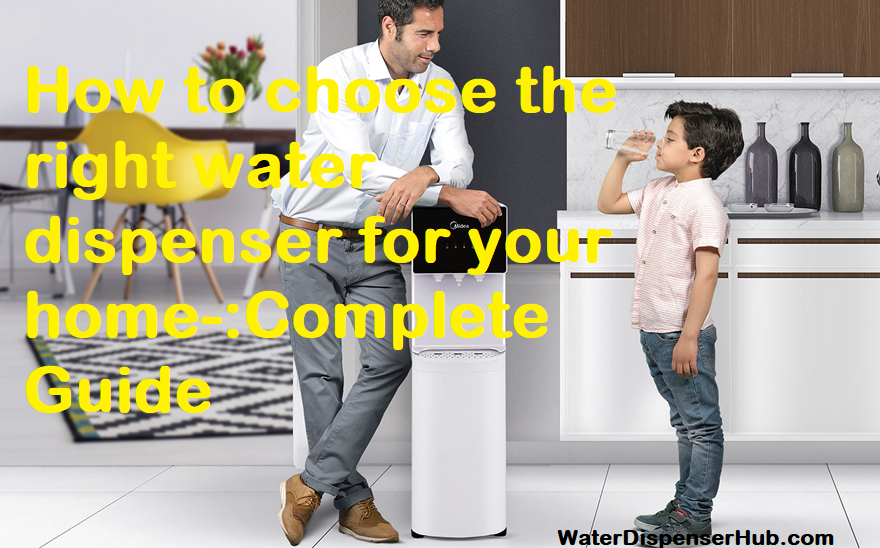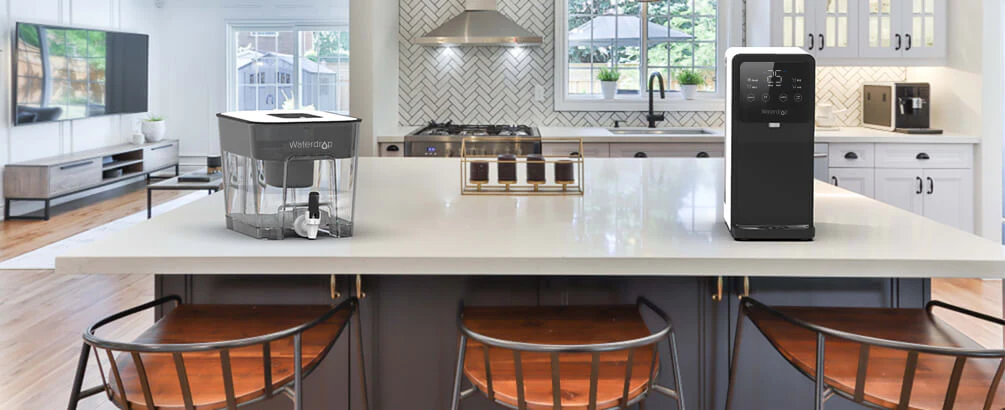Do you want to upgrade your kitchen with a water dispenser, but don’t know how to select the right one? You’ve come to the right place. We will guide you through the process of finding the best water dispenser for your house.
Here, we will explain all the different kinds of water dispensers available and their benefits. So, get ready to make an informed decision and join us in this journey!
Welcome to the complete guide on how to select the right water dispenser for your home. Water dispensers can make life more convenient by providing an accessible source of clean and filtered drinking water. They are especially useful in places with hard or soft water, as a dispenser can filter out contaminants like dirt and rust, while also providing cold and hot water options for convenience.
This guide will explore the different types of water dispensers available on the market today, so you can make an informed decision when selecting one for your home. It will discuss various factors to consider like size, budget, type of filtration technology used, and much more. We hope it helps you pick the perfect water dispenser for your specific needs.

Importance of choosing the right water dispenser
Choosing the right water dispenser is important for many reasons. Not only do you want to ensure that you have a reliable source of clean, filtered drinking water in your home, but there are also health concerns to consider. The way in which different types of water dispensers work can affect the quality and taste of your water. Some may provide more health benefits than others, depending on how advanced their filtration systems are.
Moreover, selecting a high-quality water dispenser that fits well in your overall design theme and budget can provide aesthetic appeal and improve the resale value of your home. Furthermore, it is essential to learn about the various options available so that you make an informed decision that meets the needs of your family or business.
Considering all these factors will help you choose a cost-effective and reliable unit suitable for your specific requirements while providing beneficial attributes such as hot and cold temperatures or refreshing sparkling options with convenience and safety features incorporated into its operation.
III. Factors to Consider When Choosing a Water Dispenser
Before you select a water dispenser for your home, it is important to take a few factors into account. While choosing the right type of dispenser for your needs, you should consider the following:
- Cost – Depending on how much storage capacity you require and whether or not you will be using it commercially, there are water coolers of varying price points. Compare prices from multiple vendors before deciding on one.
- Storage Capacity – Water dispensers can typically hold at least five liters of water in the reservoir while some models can store up to nineteen liters at a time. You need to decide how much water storage capacity suits your needs before selecting one particular model.
- Usage – The options range from an inexpensive top loader to more expensive bottom load models with self-sterilization features and other advanced features like temperature adjustment and electronic displays of temperature levels that allow users to adjust the temperature setting manually or according to their preference. If you will be using it at home, then lower-end top or bottom load models may suffice for occasional use but if you need professional grade dispensers for frequent commercial use then more sophisticated ones would be preferable with additional accessories such as filters and nozzles for drinking comfortability in restaurants or offices facilities.
Capacity
The capacity of the water dispenser is an important factor to consider when figuring out what type is right for your home. Generally, the amount of water a dispenser can hold will be based on type and size.
For example, bottom-loading water dispensers tend to have larger capacities than top-loading models, and can typically hold 3-5 gallons more. Countertop units offer another option, but they have the smallest capacity, making them best suited for very small households.
If you need more capacity or are looking for a unit that requires less frequent refilling, you may want to consider a freestanding model with both chilled and hot water capabilities – these usually come with larger capacities ranging from 3–14 gallons.
No matter what size or type you choose it’s important to keep in mind how much you’ll use it each day and plan accordingly.
Cooling and Heating System
The cooling and heating systems vary greatly between dispensers. The most common cooling system is the compressor, which is similar to a regular refrigerator. Compressor cooling will cool water down to approximately 39°F (4°C) and typically comes with an adjustable temperature control for users to choose their own desired temperature. Furthermore, some dispensers are even equipped with an advanced microcomputer temperature control panel that allows users to adjust the temperature, choose multiple temperature settings, set saving temperatures, or turn on/off the lock.
On the other hand, some water dispensers also offer an advanced heat exchange technology and use fans to heat water efficiently without boiling or burning it. This not only reduces sounds levels and energy consumption, but it also ensures that the taste of the water is preserved without affecting its flavor. Additionally, some high-end models are even able to maintain a constant warm setting depending on your preference. The warm setting ranges anywhere from 85-158°F (29-70°C).
Energy Efficiency
Whether you’re looking for water coolers, mains fed water coolers or hot & cold water machines, it’s important to bear in mind the energy efficiency of your chosen product. Many leading brands do place a priority on making their products as efficient as possible, helping both you and the environment save money and energy.
One way to easily tell how efficient a device is likely to be is by checking its energy rating. The higher the rating (A++ being highest), the less power it will consume. It’s also worth considering whether the machine has adjustable settings for varying amounts of temperature and cooling power – having flexibility over your settings can help save energy costs, compared to having one fixed setting which may have higher than necessary levels of cooling or heating intensity.
Water dispenser ratings:
- A+++ rated dispensers consume 40% less energy compared to A+ dispensers
- A++ rated machines are 20% more efficient than A+ devices
- A+ rated devices use 15-20% less electricity than traditional models
Finally, consider opting for mains fed water coolers – better known as plumbed in models – which provide near instantaneous access to chilled or hot drinks without needing single use bottles. This not only reduces waste from plastic bottle but cuts down on electricity expenditure due to lack of need for internal components that are found in traditional models.
Maintenance and Cleaning
Once you have selected the right water dispenser for your home, you will have to ensure that it is cleaned and maintained regularly. While unlike other kitchen appliances, which require more complex maintenance and cleaning, a cooler/water dispenser does not need intensive care and can be maintained with basic effort.
It is important to pay attention to the frequency of cleaning and maintenance when selecting a cooler/water dispenser – coolers with large reservoirs usually need less frequent cleaning than coolers with small ones. Here are a few simple tips for cleaning your cooler/water dispenser:
- Unplug the device before commencing any maintenance on it.
- Empty out all of the stored water in your cooler’s reservoir using the tap at its base (including any remaining water in its supply line).
- Remove any sediment or debris that may have accumulated in the reservoir or supply line (inspect them regularly).
- Sanitize the interior components such as taps, fascia and cover with mild soap or detergent until they are rid of dust particles or other residue. It is also recommended that you use a mild sanitizer like vinegar solution to further disinfect these components (especially if used by more than one person).
- Following this make sure to wipe off any excess moisture from these areas before reinstalling them in their original positions on your cooler/water dispenser.
- Once all components are reassembled, fill up your reservoirs with fresh drinking water so that it is available when needed.
Ideally, you should do this basic daily clean up process every time you use your cooler/water dispenser – however perform weekly deep cleanings following this same process for optimal performance from it over time.

Filtration System
When choosing a water dispenser, it is important to consider the filtration system, as this will determine the quality of water you are getting. Filtered water can be beneficial for people who live in areas with hard-water, or if there is concern about contaminants that can be present in tap-water. The level of filtration will depend on the needs of your home.
Most filtration systems use carbon filters to get rid of sediment and other impurities. These filters also reduce the levels of chlorine and other chemicals that might be present in tap-water. Some systems use reverse osmosis for more thorough filtering, which involves a process called ultrafiltration to eliminate particles like bacteria, viruses and heavy metals from your drinking water. Multi-stage filters are also available, which combine different types of filtration for better protection from impurities.
For optimal performance, filtered drinking water dispensers require periodic filter changes—approximately once every 3 to 6 months depending on usage volume and condition of your incoming source water—in order for the system to work optimally. Depending on your filter type, some filter changes may require fewer steps than others—choose one that fits with your lifestyle!
Conclusion
When choosing a water dispenser for your home, there are many factors to consider. It is important to determine the size and type of dispenser that will best meet your needs and the layout of your home. You should also consider the space available for the unit, as well as how much money you are willing or able to spend. Other factors to think about include whether the unit dispenses both hot and cold water, how easily you can access replacement filters, and whether or not bottled water is necessary.
No matter what type of water dispenser you choose, it is important to ensure that it meets all safety requirements and has been certified. This will ensure that you have clean and safe drinking water in your home at all times. With a quality machine in place, all family members can enjoy delicious filtered water without worry!
FAQ’s
What type of water dispenser is best?
The best type of water dispenser depends on your specific needs, but generally, bottom-loading dispensers with hot and cold water options are popular.
Is it worth buying a water dispenser?
If you consume a lot of water and don’t want to hassle with constantly refilling a pitcher or water bottles, a water dispenser can be a convenient and cost-effective option.
Which water dispenser is best in India?
There are many good water dispenser brands in India, including Blue Star, Voltas, and Usha. The best one for you depends on your specific needs and budget.
Is water dispenser good for home?
Yes, water dispensers are a good option for home use, especially for larger families or those who consume a lot of water.
Is glass or plastic water dispenser better?
Glass water dispensers are generally considered to be better for health and the environment, but plastic dispensers are more affordable and durable.
Is internal water dispenser better than external?
Internal water dispensers are more convenient and space-saving, but external dispensers may be easier to maintain and clean.
Which is better water purifier or water dispenser?
A water purifier is better if you want to ensure the water you drink is free of impurities, while a water dispenser is better if you want a convenient way to dispense large quantities of water.
Which dispenser is the best?
There is no one “best” dispenser, as the best one for you depends on your specific needs and preferences. However, some top brands include Whirlpool, Samsung, and LG.
How long do water dispensers last?
The lifespan of a water dispenser depends on the brand and model, but with proper maintenance and care, they can last for several years.
Does dispenser purify water?
Not all water dispensers have built-in purifiers, so it’s important to check the specifications before purchasing. Some dispensers have filters or UV purification systems that can help purify the water.
See more-
- Best 5 gallon water dispenser 2023
- Best water dispenser with filter 2023
- Best bottleless water dispenser 2023
- Best water dispenser 2023
- Best hot water dispenser 2023

Robert Carlson is the CEO of waterdispenserhub.com and informative website, and a respected author in the dispenser industry. With years of experience and a passion for his work, Robert has become a trusted source of information for consumers and businesses alike. His dedication to excellence and commitment to providing unbiased and independent reviews have earned him a loyal following of readers who trust his expertise and insights. Robert is a true industry expert and a leader in the dispenser industry, and his work has been recognized by his peers and featured in various publications and media outlets.

